QE2 Backfires, Collapse in Irish and U.S. Bond Markets
Interest-Rates / Global Debt Crisis Nov 18, 2010 - 11:58 AM GMTBy: Gary_Dorsch
 “Oh what a tangled web we weave when first we practice to deceive,” said Sir Walter Scott. The Republican Party enjoyed a major victory in the congressional midterm elections, winning back control of the House of Representatives and gaining seats in the Senate. Republican leaders are giving the Tea Party movement a lot of credit for their success, and one of its high profile leaders, Kentucky’s Senator-elect, Rand Paul declared, “We’ve come to take our government back.”
“Oh what a tangled web we weave when first we practice to deceive,” said Sir Walter Scott. The Republican Party enjoyed a major victory in the congressional midterm elections, winning back control of the House of Representatives and gaining seats in the Senate. Republican leaders are giving the Tea Party movement a lot of credit for their success, and one of its high profile leaders, Kentucky’s Senator-elect, Rand Paul declared, “We’ve come to take our government back.”
The Tea Party is a grassroots, conservative, and libertarian movement dedicated to reducing the power of Washington DC’s politicians in the lives of ordinary Americans. Tea Party supporters view the nations’ $14-trillion debt as the biggest danger facing the economy. The US federal budget has gone from a surplus of $236-billion the year President George Bush took office to a $1.5-trillion deficit during President Barack Obama’s first year. The Tea Party’s revulsion against the spending binge in Washington has hit a chord with the American public.
Also, the hostility toward the Federal Reserve is very strong among the followers of the Tea Party, with 55% of its supporters demanding that the Fed should be abolished or radically overhauled. The Tea Party aims to audit the Fed’s secret operations, and wants to break the link between the Fed and a small group of Wall Street Oligarchs that are making lots of money at the expense of US-taxpayers.
“I think that private individuals are making money with the transactions that the Fed is involved with, and US-taxpayers deserve to know, if someone is making hundreds of million dollars buying and selling these new US-assets. We also need to know who they are, and what are they paying for these assets, and if this being done honestly,” said Kentucky’s next Senator Rand Paul.
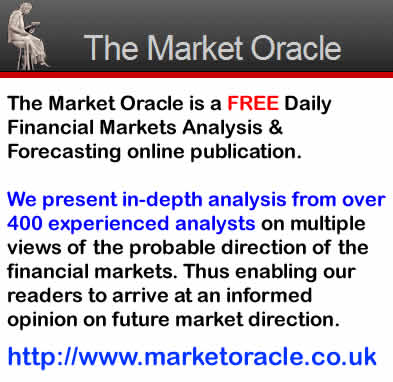 Randall Paul opposes the Fed’s control of the money supply and interest rates, and instead, wants the free market to set interest rates. Additionally, Paul supports “restoring the value of the US-dollar that has devalued by 95% since the Fed’s inception in 1913.” Another Tea Party favorite, Sarah Palin, former Alaska governor, has accused the Fed of conducting “dangerous experiments with our currency.”
Randall Paul opposes the Fed’s control of the money supply and interest rates, and instead, wants the free market to set interest rates. Additionally, Paul supports “restoring the value of the US-dollar that has devalued by 95% since the Fed’s inception in 1913.” Another Tea Party favorite, Sarah Palin, former Alaska governor, has accused the Fed of conducting “dangerous experiments with our currency.”
In an extraordinary turn of events, the Fed’s scheme to devalue the US-dollar, and monetize the government’s debts, through a radical process known as QE-2, has become a political lightning rod, pitting liberal Democrats and supporters of QE-2, against conservative Republicans and Tea Party opponents of QE-2. In the battle for public opinion, President Barack Obama has sided with the clandestine group of bankers, who control the Fed. And while the Fed justifies QE-2 in the name of stimulating job creation, its main aim is to increase the supply of virtually free credit to the Wall Street Oligarchs and fuel bubbles in the stock market.
During a visit to India on Nov 10th, Obama argued that QE-2 is in the world’s best interests. “I will say that the Fed’s mandate, my mandate, is to grow our economy. And that’s not just good for the United States, that’s good for the world as a whole. And the worst thing that could happen to the world economy, not just ours, is if we end up being stuck with no growth or very limited growth,” Obama argued. But left out from Obama’s remarks was the Fed’s mandate to control inflation.
Tea Party favorite Sarah Palin weighed in the debate over the Fed’s QE-2-scheme, calling upon Fed chief Ben Bernanke to “cease and desist” from his suicidal addiction to printing money. “We shouldn’t be playing around with inflation. We don’t want temporary, artificial economic growth bought at the expense of permanently higher inflation which will erode the value of our incomes and our savings. We want a stable dollar combined with real economic reform. It’s the only way we can get our economy back on the right track,” Palin said.
Palin went on to say, “What’s the end game here? Where will all this money printing on an unprecedented scale take us? Do we have any guarantees that QE-2 won’t be followed by QE-3, QE-4, and QE-5, until eventually, - inevitably, - no one will want to buy our debt anymore?” Palin asked. However, the unelected officials, who were appointed to the Bernanke Fed aren’t listening. They have a hidden agenda.
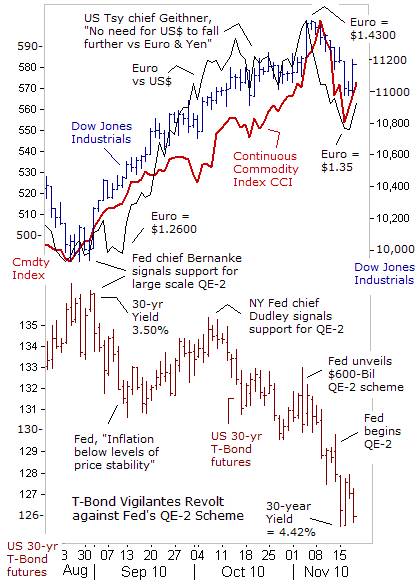 The Fed first began telegraphing its intention to unleash QE-2 upon the world money markets, at its annual conference in Jackson Hole, Wyoming, on August 28th. In the background, the Dow Jones Industrials had just tumbled below the psychological 10,000-level, after falling 700-points over the previous three weeks. The stock market was beset by fears of a “double-dip” recession, and a “deflationary spiral.” The US economy’s growth rate slowed to an annual pace of +1.6%, and less than half the +3.7% rate in the previous quarter. The U-6 jobless rate, measuring unemployed, discouraged, or involuntarily part-time workers rose to 25-million, or 16.5% of the labor force, or one in six Americans.
The Fed first began telegraphing its intention to unleash QE-2 upon the world money markets, at its annual conference in Jackson Hole, Wyoming, on August 28th. In the background, the Dow Jones Industrials had just tumbled below the psychological 10,000-level, after falling 700-points over the previous three weeks. The stock market was beset by fears of a “double-dip” recession, and a “deflationary spiral.” The US economy’s growth rate slowed to an annual pace of +1.6%, and less than half the +3.7% rate in the previous quarter. The U-6 jobless rate, measuring unemployed, discouraged, or involuntarily part-time workers rose to 25-million, or 16.5% of the labor force, or one in six Americans.
In order to arrest the slide in the stock market, Fed chief Bernanke signaled that the central bank was ready to cross the Rubicon into the world of QE-2. “The issue at this stage is not whether we have the tools to help support economic activity and guard against disinflation. We do! Should further action prove necessary, policy options are available. The Fed will strongly resist deviations from price stability in the downward direction,” he told a gathering of central bankers and economists.
Bernanke’s suggestion that QE-2 was necessary to stave off a “double-dip” recession roiled world currency markets, sending the US-dollar sharply lower against the Euro, the yen, and emerging currencies, and propelling gold to record highs. New York Fed chief William Dudley, explained to the media on October 1st, that printing $500-billion under the guise of QE-2, would be the equivalent of the Fed lowering the federal funds rate, by a half-percent. In other words, the Fed aims to drive the fed funds rate below zero-percent for the first time in history.
The Fed’s QE-2 scheme is portrayed by its propaganda artists, as an insurance policy against the possibility of a “deflationary spiral.” Yet in fact, the prospect of QE-2 set in motion a buying frenzy into a broad array of commodities and precious metals. The Continuous Commodity Index (CCI) climbed +23% higher in just ten-weeks, elevating to within 5% of its all-time highs. However, the Bernanke Fed doesn’t interpret booming commodity markets as harbinger of accelerating inflation.
In fact, food and energy prices aren’t even included in the Fed’s preferred model of the consumer price index. Instead, the Fed blames booming commodity prices on voracious demand by rapidly growing nations, such as China and India, and will never admit that its cheap US-dollar policy is fueling global inflation. Above all else, the Fed is determined to insure the massive flow of cheap credit to the Wall Street Oligarchs, which are recording bumper profits of $19-billion this year, the fourth highest total ever, helped by the Fed’s efforts to jig stock prices higher.
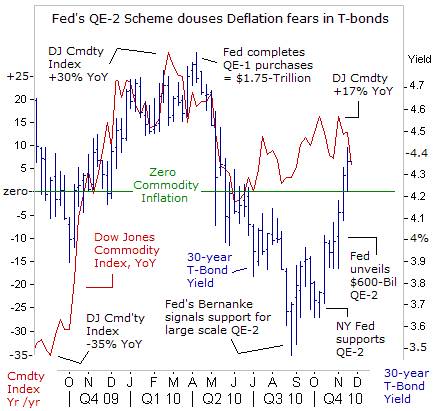 So far, the biggest casualty of the Fed’s QE-2 scheme is the Treasury’s 30-year bond. Its yield has zoomed 100-basis points higher since late August, to as high as 4.42% this week. Long bonds were priced for the probability of a “double-dip” recession and a “deflationary spiral.” Instead, the Fed’s shift to QE-2 has whipped up fears of accelerating inflation, and has stirred the animal spirits among traders to bid-up commodities and precious metals.
So far, the biggest casualty of the Fed’s QE-2 scheme is the Treasury’s 30-year bond. Its yield has zoomed 100-basis points higher since late August, to as high as 4.42% this week. Long bonds were priced for the probability of a “double-dip” recession and a “deflationary spiral.” Instead, the Fed’s shift to QE-2 has whipped up fears of accelerating inflation, and has stirred the animal spirits among traders to bid-up commodities and precious metals.
The Fed’s QE-2 scheme, “introduces significant uncertainty regarding the future strength of the US-dollar and could result both in hard-to-control, long-term inflation and potentially generate artificial asset bubbles that could cause further economic disruptions,” Republican leaders of the House and Senate wrote on Nov 17th.
Economists at the St Louis Fed figure that for every $100-billion pumped into the Treasury market under the Fed’s QE-2 operations, it would lower the yield on the US T-Note by 10-basis points. However, such fanciful calculations have gone awry. Trying to push T-bond yields lower, while trying to generate faster inflation at the same time, is like trying to submerge a helium filled balloon under water. Instead, 10-year T-Note yields jumped 40-bps higher. The yield spread between 30-year and 10-year bond widened to a record high of +160-basis points. In other words, QE-2 has boomeranged, and is leading to sharply higher bond yields.
“Simply running the printing presses in order to pay-off your debts is no way for a great nation to behave,” warns Ms Palin. Indeed, another way to understand the hidden meaning of QE-2 is that the market’s worst fears are being realized – the US-government is essentially bankrupt, and can no longer service its debt, by running a balanced budget. Instead, the only thing standing in the way of an outright default by the US-government on its debts, - is the Fed’s electronic printing press. Still, China and Japan were net buyers of $43-billion of US T-Notes in September, - and so, the shell game goes on awhile longer.
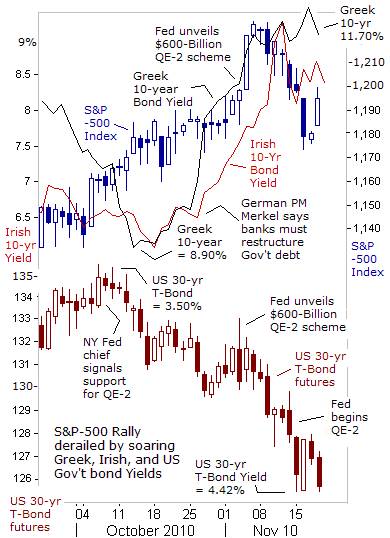 Last week, yields on Ireland’s 10-year bond soared to as high as 9.25% from around 6.05% a month ago. Ireland has begun preliminary talks with the European Union, trying to securing a financial bailout to avert state bankruptcy. Dublin is thought to require €60-80 billion in emergency loans. If correct, borrowing on such a scale would push Ireland’s gross debt towards 115% of its GDP. Yet the temporary bailout would come at a cost of piling spending cuts and tax increases on the Irish economy, which is already subject to the most savage austerity measures in Europe.
Last week, yields on Ireland’s 10-year bond soared to as high as 9.25% from around 6.05% a month ago. Ireland has begun preliminary talks with the European Union, trying to securing a financial bailout to avert state bankruptcy. Dublin is thought to require €60-80 billion in emergency loans. If correct, borrowing on such a scale would push Ireland’s gross debt towards 115% of its GDP. Yet the temporary bailout would come at a cost of piling spending cuts and tax increases on the Irish economy, which is already subject to the most savage austerity measures in Europe.
The latest upward spiral in Greek and Irish bond yields were triggered by German Chancellor Angela Merkel, who called upon on Euro-zone banks to restructure the debts of Greece, Ireland, and other troubled debtors, - and agree to take a big “haircut.” “Creditors need to be involved in the costs of restructuring,” Merkel said. “There may be a conflict here between the interests of the financial world and the interests of politicians. We can’t constantly explain to our voters that taxpayers have to be on the hook for certain risks, rather than those who make a lot of money taking those risks. I ask the markets sometimes to bear politicians in mind, too.”
Investing in Greek and Irish bonds is very risky. Athens and Dublin would lack the funds to pay their debts at full face value, once the EU’s emergency funds run dry in May 2013. As a member of the Euro currency, Ireland’s central bank cannot print money to monetize its debts. Likewise, if foreign bond holders start to grow weary of the Fed’s QE schemes, and begin to realize that the US government is essentially bankrupt, and can only pay off its debts by printing dollars, then the upward climb in US Treasury bond yields has only just begun. An upward spike in T-bond yields could deal a sharp blow to the highly indebted US-economy, and its fragile housing sector.
There was so much euphoria on Wall Street, after reading Mr Bernanke’s Nov 3rd, Op-Ed piece in the Washington Post, that made it very clear, - the Fed’s primary goal is to artificially jig-up the stock market, as a tool to reduce unemployment. Higher stock values, according to the “wealth effect,” will restore confidence as Americans see their savings rebound. Improved confidence leads to additional spending, which could ultimately lower unemployment. However, in order for that magic trick to work, the Fed must show its ability to keep the bond vigilantes under wraps.
It was unclear how successful Bernanke will be in placating a growing number of his critics. “Basically, what he is doing is experimenting,” said Richard Shelby, Republican of Alabama. “He basically admitted that he’s tinkering.” Furthermore, Fed officials appear to be out of sync with market psychology. Soon after St. Louis Fed chief James Bullard told the media, the Fed would utilize its fill $600-billion allotment of QE-2, the US-Treasury’s 30-bond plunged a full point.
The S&P-500 Index hasn’t acted according to the Fed’s script either. It tumbled 50-points from its QE-2 peak high of 1,224. Jittery stock market bulls must now grapple with threats on three fronts – ranging from an unrelenting slide in US T-bonds, and the upward spiral in Greek and Irish bond yields. To make matters worse, the Chinese central bank is tightening its monetary policy, and lifting interest rates, trying to slowdown the locomotive of the world economy, in order to combat an inflationary spiral that was fueled by the Fed’s QE-2 scheme.
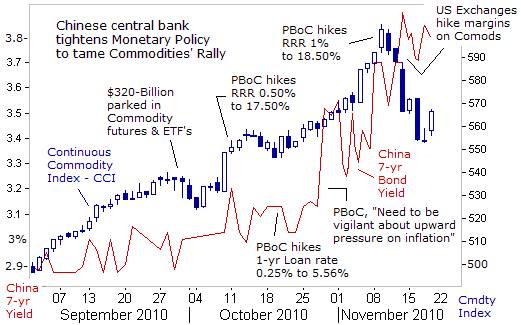 With the Fed determined to inject $600-billion into the world economy, the task of combating its inflationary effects, have fallen on the shoulders of Beijing. Chinese consumer prices were +4.4% higher in October than a year ago, and Chinese banks extended 588-billion yuan ($88-billion) of new yuan loans in October. The broad M2 money supply was +19.3% higher than a year ago. Strong credit and M2 expansion, combined with the Fed’s QE-2 scheme, suggests a massive pool of liquidity would still buoy the commodity markets in the months ahead. On Nov 11th, the People’s Bank of China (PBoC) hiked required reserve ratios (RRR) by 50-basis points for all lenders to 18%, and took an extra tightening step, lifting the required reserve ratio to a record 18.5% for the country’s biggest banks, - draining.
With the Fed determined to inject $600-billion into the world economy, the task of combating its inflationary effects, have fallen on the shoulders of Beijing. Chinese consumer prices were +4.4% higher in October than a year ago, and Chinese banks extended 588-billion yuan ($88-billion) of new yuan loans in October. The broad M2 money supply was +19.3% higher than a year ago. Strong credit and M2 expansion, combined with the Fed’s QE-2 scheme, suggests a massive pool of liquidity would still buoy the commodity markets in the months ahead. On Nov 11th, the People’s Bank of China (PBoC) hiked required reserve ratios (RRR) by 50-basis points for all lenders to 18%, and took an extra tightening step, lifting the required reserve ratio to a record 18.5% for the country’s biggest banks, - draining.
Beijing guided the 7-year Chinese T-bond yield 90-basis points higher over the past few weeks to 3.80% today, in a belated move to rein-in speculation in the Dalian and Zhengzhou commodity markets. The PBoC has mostly relied on adjusting its RRR to control its money supply, but the strategy is flawed, since Chinese interest rates are still positioned far below the inflation rate, - thus negative bond yields encourages speculation in commodities, precious metals, and Shanghai red-chips.
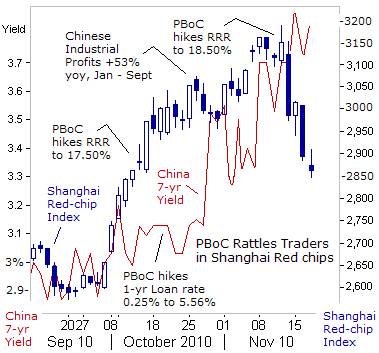 Shanghai and Hong Kong stocks fell to multi-week lows on Nov 17th, on reports that Beijing is willing to hike interest rates again, in order to tackle the country’s accelerating inflation rate. The tumble that started on Nov 12th shaved 11% off the Shanghai red-chip index. The Chinese Politburo is utilizing almost all of its weapons for combating inflation, except for the one that Washington advocates, - lifting the yuan against the US-dollar at a quicker pace.
Shanghai and Hong Kong stocks fell to multi-week lows on Nov 17th, on reports that Beijing is willing to hike interest rates again, in order to tackle the country’s accelerating inflation rate. The tumble that started on Nov 12th shaved 11% off the Shanghai red-chip index. The Chinese Politburo is utilizing almost all of its weapons for combating inflation, except for the one that Washington advocates, - lifting the yuan against the US-dollar at a quicker pace.
However, on Nov 17th, Zhou Qiren a key adviser to the PBoC said Chinese rate hikes are no panacea for curbing inflation. “Loose monetary policy in 2009 has created excessive liquidity and helped fuel prices of various products. Too much liquidity and fewer goods is the reason behind inflation. Raising interest rates cannot change such a situation,” he told the China Securities Journal. Thus, if Chinese and Chicago commodity markets manage to rebound strongly from their latest shake-out, it would signal that inflationary pressures are deeply entrenched. The PBoC would be faced with the biggest inflation threat to its economy in decades.
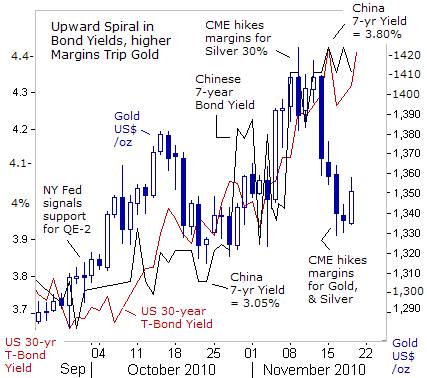 Meanwhile, the Fed is scheduled to buy $105-billion of Treasury securities from Nov 12th, through Dec 9th, which in turn, might fuel another tidal wave of liquidity into the global commodities and metals markets. Gold and Silver have tumbled from their recent highs, spooked by hefty increases in margin requirements, set by the US-exchange operators, for agricultural and metal futures.
Meanwhile, the Fed is scheduled to buy $105-billion of Treasury securities from Nov 12th, through Dec 9th, which in turn, might fuel another tidal wave of liquidity into the global commodities and metals markets. Gold and Silver have tumbled from their recent highs, spooked by hefty increases in margin requirements, set by the US-exchange operators, for agricultural and metal futures.
Given the extraordinary efforts of the bond market vigilantes in jacking-up US Treasury yields, and the upward drift in Chinese yields, the mountain that the precious metals’ bulls must climb has gotten steeper. However, one should also keep in mind, that Chinese bond yields are still far below the inflation rate, and therefore, offering a negative rate of return. In regards to the US T-bond market, if there’s a growing realization that the US-government is bankrupt, and can only pay back its debts by printing paper, then precious metals are a safe haven.
So far, the actual results of the Fed’s QE-2 scheme are horrifying. Monetizing the Treasury’s debt on such a massive scale has only reawakened the bond vigilantes from their slumber. If the Fed cannot stop the slide in T-bond prices, and bond yields ratchet sharply higher, the euphoria in the stock markets over QE-2 is misguided. A similar example is the events leading up to Back Monday, October 1987. At best, the results of QE-2 would simply guide the US-economy into the “Stagflation” trap.
This article is just the Tip of the Iceberg of what’s available in the Global Money Trends newsletter. Subscribe to the Global Money Trends newsletter, for insightful analysis and predictions of (1) top stock markets around the world, (2) Commodities such as crude oil, copper, gold, silver, and grains, (3) Foreign currencies (4) Libor interest rates and global bond markets (5) Central banker "Jawboning" and Intervention techniques that move markets.
By Gary Dorsch,
Editor, Global Money Trends newsletter
http://www.sirchartsalot.com
GMT filters important news and information into (1) bullet-point, easy to understand analysis, (2) featuring "Inter-Market Technical Analysis" that visually displays the dynamic inter-relationships between foreign currencies, commodities, interest rates and the stock markets from a dozen key countries around the world. Also included are (3) charts of key economic statistics of foreign countries that move markets.
Subscribers can also listen to bi-weekly Audio Broadcasts, with the latest news on global markets, and view our updated model portfolio 2008. To order a subscription to Global Money Trends, click on the hyperlink below, http://www.sirchartsalot.com/newsletters.php or call toll free to order, Sunday thru Thursday, 8 am to 9 pm EST, and on Friday 8 am to 5 pm, at 866-553-1007. Outside the call 561-367-1007.
Mr Dorsch worked on the trading floor of the Chicago Mercantile Exchange for nine years as the chief Financial Futures Analyst for three clearing firms, Oppenheimer Rouse Futures Inc, GH Miller and Company, and a commodity fund at the LNS Financial Group.
As a transactional broker for Charles Schwab's Global Investment Services department, Mr Dorsch handled thousands of customer trades in 45 stock exchanges around the world, including Australia, Canada, Japan, Hong Kong, the Euro zone, London, Toronto, South Africa, Mexico, and New Zealand, and Canadian oil trusts, ADR's and Exchange Traded Funds.
He wrote a weekly newsletter from 2000 thru September 2005 called, "Foreign Currency Trends" for Charles Schwab's Global Investment department, featuring inter-market technical analysis, to understand the dynamic inter-relationships between the foreign exchange, global bond and stock markets, and key industrial commodities.
Copyright © 2005-2010 SirChartsAlot, Inc. All rights reserved.
Disclaimer: SirChartsAlot.com's analysis and insights are based upon data gathered by it from various sources believed to be reliable, complete and accurate. However, no guarantee is made by SirChartsAlot.com as to the reliability, completeness and accuracy of the data so analyzed. SirChartsAlot.com is in the business of gathering information, analyzing it and disseminating the analysis for informational and educational purposes only. SirChartsAlot.com attempts to analyze trends, not make recommendations. All statements and expressions are the opinion of SirChartsAlot.com and are not meant to be investment advice or solicitation or recommendation to establish market positions. Our opinions are subject to change without notice. SirChartsAlot.com strongly advises readers to conduct thorough research relevant to decisions and verify facts from various independent sources.
Gary Dorsch Archive |
© 2005-2022 http://www.MarketOracle.co.uk - The Market Oracle is a FREE Daily Financial Markets Analysis & Forecasting online publication.



